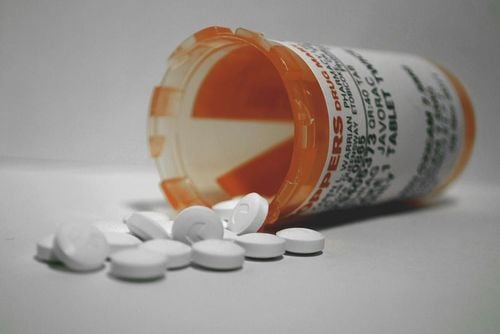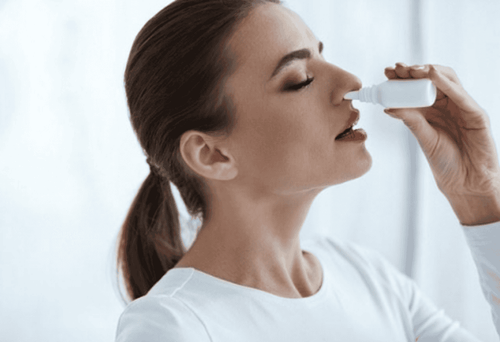This is an automatically translated article.
Bolorate drug has the main active ingredient Loratadin 10mg and other excipients in sufficient quantity. This is an anti-allergic drug and used in cases of hypersensitivity. This medicine is indicated for the treatment of allergic conditions such as allergic rhinitis, sneezing, itchy nose and allergic skin reactions such as hives or rash,...
1. What is Bolorate?
1.1. Composition and preparation of the drug Bolorate Bolorate drug has the main active ingredient Loratadin 10mg and other excipients in sufficient quantity. This is an anti-allergic drug and used in cases of hypersensitivity. This drug is indicated for the treatment of allergic cases such as allergic rhinitis, sneezing, itchy nose and allergic skin reactions such as hives or rash,...
Bolorate drug prepared In tablet form, suitable for direct oral use. Packing is a box of 3 blisters and each blister contains 10 pills. With the active ingredient Loratadin, each Bolorate tablet has all the physicochemical properties of this substance.
1.2. Pharmacodynamics of the active ingredient Loratadin Main active ingredient Loratadin is a 2nd generation antihistamine. Compared with the 1st generation drug, Loratadin has many outstanding advantages that are no effect on the central nervous system and the central nervous system. long duration of effect. The mechanism of action of this active substance is by acting on peripheral H1 receptors. As a result, when using drugs containing the active ingredient Loratadin in the treatment of allergies is very effective.
1.3. Pharmacokinetics of the active ingredient Loratadine In terms of pharmacokinetics, after taking the drug, the active ingredient Loratadine will be rapidly absorbed and bound to most proteins in the plasma. The drug is metabolized in the liver to many intermediate products that are still active and finally eliminated from the body in the feces and urine.
1.4. Loratadine Loratadine is a tricyclic antihistamine with long-acting selective antagonism of peripheral H1 receptors and without CNS depressant effects. The main active ingredient Loratadin is also used in anti-itching and urticaria related to the use of histamine. However, the active ingredient Loratadin has no protective or clinical supportive effect in cases of severe histamine release, such as anaphylaxis.
Active ingredient Loratadine has no sedative effect, in contrast to the side effect of sedation of first-generation antihistamines.
2. What disease does Bolorate treat?
2.1. Treatment of Allergic Rhinitis Bolorate is indicated for symptoms associated with allergic rhinitis including sneezing, runny nose, itchy nose, as well as itchy and burning eyes. Clinical studies have shown that 1 daily dose of loratadine reduces the signs and symptoms of seasonal rhinitis . Bolorate is also indicated in the symptoms of recurring rhinitis and hay fever or pollen allergy. 2.2. Treatment of symptomatic signs of urticaria and skin allergies Bolorate is indicated for the symptomatic treatment of chronic urticaria. Treatment of other allergic skin disorders. Treatment of skin rash with the first time. The drug begins to work after about 30 minutes after taking Bolorate 10mg tablets and is effective for 24 hours.
3. Usage and dosage of Bolorate drug
3.1. Dosage of Bolorate drug Depending on the specific case, the dose may be different.
Reference treatment dose, specifically as follows:
For adults and children over 12 years old: take 1 pill per day, 1 pill each time. For people with liver and kidney failure: take 1 pill once a day, 1/2 pill each time or 1 pill every 2 days. Use with caution in children under 12 years of age. The therapeutic dose should be carefully followed the instructions of the treating doctor. It should be noted: The dose of Bolorate as mentioned above is for reference only, patients with symptoms of the disease need to go to medical centers for examination. After the diagnosis process, the treating doctor will determine the pathology and give a reasonable treatment and prescription, as well as an effective diet.
3.2 How to use Bolorate effectively Bolorate drug is prepared in the form of tablets, suitable for direct oral use. Swallow the tablet whole with water, do not chew or crush the tablet. Take Bolorate exactly according to the dose and instructions prescribed by your treating doctor.
4. In case of overdose of Bolorate drug
4.1. Signs of a Bolorate Overdose Taking an overdose of Bolorate can cause drowsiness, rapid heart rate, and headache. A single dose of 160mg has no adverse effects. In case of overdose, you should immediately treat symptomatic and supportive treatment. 4.2. Treatment of Bolorate Overdosage People who have overdosed on the drug should be induced to vomit, although vomiting is also possible in the event of an overdose. The most commonly used method is to induce vomiting with syrup of ipeca. However, it is not recommended to induce vomiting in people with reduced consciousness. The effects of ipeca syrup are supported by mechanical movements and by oral administration with approximately 240 to 360 ml of water. If the user does not vomit within 15 minutes, the dose of ipeca should be re-administered. Prevention of the risk of aspiration of vomitus into the respiratory tract, especially in children. After vomiting, it is recommended to use activated charcoal mixed with water to absorb the remaining pharmaceutical products in the stomach. In case of unsuccessful induction of vomiting or contraindications, gastric lavage should be performed. The solution chosen for gastric lavage is physiological saline, especially for children. For adults, water can be used; however, should be removed as much as possible, prior to another flush. Saline detergent carries water into the intestinal tract by osmosis, so it also has a rapid dilution effect of the contents of the intestine. Active ingredient Loratadine is not eliminated through dialysis to any extent, and patients need to continue to be monitored after emergency treatment.
5. Undesirable effects of the drug Bolorate
During the use of Bolorate, users may experience some unwanted effects, such as allergic reactions, hypersensitivity, nausea, vomiting, headache, fatigue, dizziness, dizziness. .
If the user experiences the above-mentioned signs or symptoms or any other abnormality when taking the drug, it is necessary to notify the treating doctor for advice on reducing the dose, stopping the use of the drug in the following cases. necessary case.
The above does not include all the unwanted effects that may occur to the user. You need to pay attention to proactively notify your treating doctor for medical advice about adverse effects when using Bolorate.
6. Bolorate drug interactions
Bolorate drug interactions that may occur during use are as follows:
When co-administered with alcohol, the main active ingredient Loratadine is not as potent as measured in psychomotor studies. In controlled clinical trials, an increase in loratadine plasma concentrations of the active ingredient was observed after co-administration with ketoconazole, erythromycin or cimetidine, but no significant change (including changes in change on the electrocardiogram). Caution should be exercised when Bolorate is co-administered with medicinal products known to inhibit hepatic metabolism until full interaction studies are available. Effect of Bolorate on Test Results: Tablets containing the active ingredient Loratadin should be discontinued approximately 48 hours before conducting skin tests. This is because antihistamines can eliminate or reduce the signs of positive skin reactions. Drugs that may interact with Bolorate: Bolorate's interactions may change its ability to work or increase the effects of unwanted effects. You need to take the initiative in listing to your treating physician or clinical pharmacist all prescription and over-the-counter medicines, herbal products or health foods that you are taking. used to minimize the types of interactions that may cause unwanted effects on the health of the user. Interactions of Bolorate with food and drinks: When using this drug with foods or alcohol, beer, tobacco, etc., because those foods and drinks contain other active ingredients, so may have an antagonistic or synergistic effect with this drug. You need to actively read the drug instructions carefully or consult your doctor about how to use Bolorate with foods, drinks containing alcohol and tobacco.
7. Some notes when using Bolorate drug
7.1. Contraindications of the drug Bolorate Absolutely do not use Bolorate with people who are sensitive or sensitive to any of the ingredients of the drug. Contraindicated for people with some comorbidities such as liver failure, severe kidney failure. Do not use Bolorate for children under 2 years old because the child's mucosa is still thin, so it can be dangerous during the use of the drug. Do not use Bolorate for pregnant and breastfeeding women. 7.2. Attention and caution when using Bolorate drug Attention and caution when using Bolorate drug in the following cases:
Subjects are children. Read the instructions for use carefully before taking Bolorate. Do not overdose because there is a higher risk of unwanted effects. Absolutely do not forget the dose of Bolorate, because it will affect the effectiveness of the treatment. Do not arbitrarily stop using the drug without consulting your doctor. Do not use Bolorate when the expiry date has expired, the medicine shows signs of damage such as: broken, discolored, moldy,... 7.2 Notes for use on special subjects Caution when using: People Patients with severe hepatic impairment should use a lower initial dose due to reduced clearance of Loratadine. The starting dose for these people is 5mg or 5ml daily or 10mg or 10ml every 2 days. Use of Bolorate in children: The safety and effectiveness of Loratadin active ingredient have not been confirmed when used in children under 2 years of age. Use of Bolorate in pregnancy: The safety of using the drug during pregnancy has not been established. Therefore, it should be used only when the benefits of Bolorate have been found to outweigh the possible risks to the fetus. Use of drugs in breast-feeding: Active ingredient Loratadine is excreted in breast milk and increases the risk of antihistamines for newborns and premature babies, so either breast-feeding should be discontinued or Bolorate should be discontinued during pregnancy. breastfeeding time. Store Bolorate in a dry place, at a temperature of 15-30 degrees Celsius in tightly closed containers, away from moisture and away from direct light. Besides, it is necessary to store Bolorate medicine out of the reach of children and family pets. Absolutely do not use Bolorate when it has expired, watery, distorted, or shows signs of metamorphosis. You should consult the environmental protection company for how to dispose of the medicine. Absolutely do not arbitrarily flush the medicine down the toilet or water pipe.
In short, Bolorate drug has the main active ingredient, Loratadin, with a strength of 10mg. Bolorate is used in the treatment of allergies. When prescribed by a doctor, you need to carefully read the instructions for use, consult your treating doctor/clinical pharmacist before using the drug. Absolutely do not arbitrarily buy Bolorate to treat the disease at home, because there may be unwanted side effects on health.
Follow Vinmec International General Hospital website to get more health, nutrition and beauty information to protect the health of yourself and your loved ones in your family.
Please dial HOTLINE for more information or register for an appointment HERE. Download MyVinmec app to make appointments faster and to manage your bookings easily.













